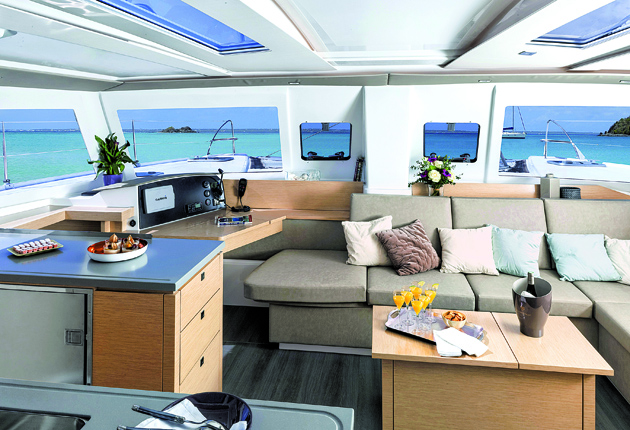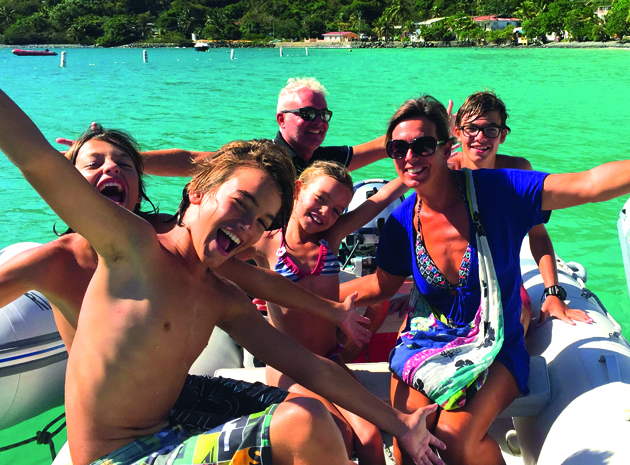Valuable pros and cons
We wanted to know what drew other owners to cruising multihulls. Space and comfort is obviously the biggest draw. But we also learned some valuable pros and cons of catamaran cruising, beyond the expected ones such as shoal draught and flat-level living.
We also asked our sample sailors for some top tips for those looking to buy a catamaran:
√ √ √ PROS:
Space for living
- There is no denying the sheer quantity of living space above the waterline. “On our Leopard 44, we have a seating area for up to five ahead of the mast, seating for six in the saloon and six in the cockpit,” says Kevin Rush. “This was useful when crossing the Atlantic as we could find our own individual space and not be on top of each other.”

- Cats have the capacity to carry a larger dinghy that can extend your exploration range at anchor.
- “More space for solar panels, hence less generator noise; better UV protection; easy dinghy handling; more privacy,” declares Reinhard Siede.
Stable platform
- Around 80-90 per cent of a liveaboard’s time is spent at anchor, so having as large, stable and comfortable a platform as possible makes sense. Frank Lambrechts converted to a Lagoon 450 after owning three monohulls “to have more liveaboard space when at anchor. Away from our home port, we are at anchor six nights out of seven, sometimes more,” he says.
- A catamaran is more stable for moving about on deck at sea, and for sail handling, setting downwind sails, etc. So the crew is typically more rested on passage. “The broader beam also makes management of safety equipment (eg drogues) easier,” reports Kevin Rush.
- “You can invite guests who are not sailors and give them an unforgettable sailing experience,” says Maarten Franken, whose parents, now in their late 70s, regularly join them aboard.

Safety at sea
- “The catamaran is a better platform for downwind sailing in a following sea – which you find on the majority of westabout circumnavigations,” maintains Russ Owen. “Her stability and wide stance allows us to fly gennakers for days at a time at sea, without worrying about the ‘death rattle broach’ that monohulls can experience in those conditions.”
- “Upright stability gives you better radar range and VHF radio range than a heeling platform does.” Russ Owen again.
- “Unsinkable; two engines; no spinnaker pole needed.” Reinhard Siede.
- “Visibility, stability underway and at anchor, redundant engine and equipment-carrying capacity.” Michael Roberts.
x x x CONS:
Costs
- Mooring costs are between 1.5 and two times that of a monohull – however, it can be argued that you gain a similar ratio in extra volume.
- “The wide beam limits your haul-out options,” reports Michael Roberts.
- Maintenance: there are two hulls to keep clean, two engines to service, two rudders and more seacocks, etc, to maintain.
Performance to windward
- When sailing to windward heavily laden, a catamaran will typically surrender at least 10º in leeway or pointing ability to a monohull. However Kevin Rush argues that “even if half of your sailing is done upwind, this under-performance impacts less than ten per cent of the time that you are on the boat”.
- “Tacking can be frustrating; and there is no performance downwind without a spinnaker or Parasailor because the genoa is too small,” admits Reinhard Siede. “Sailing is not really fun – it is like driving a bus instead of a sports car.”
- “The catamaran ride is smoother, but not for everyone,” says Russ Owen. “Even a well-found bluewater cat with high bridgedeck clearance has a rough ride to windward in choppy waves.”
Bulky design
- Freeboard height means boarding typically needs to be done via transom steps. The freeboard of production cats is more comparable to 60ft monohulls, hence they can present the same difficulties in an MOB retrieval situation.
- Windage: high freeboard means that cats have a lot more windage than monohulls and tend to sail back-and-forth at anchor and pull on their lines in harbour.
- “More noise upwind; more noise from furniture; high purchase price; special downwind sails required.” Reinhard Siede.
- Finally, there is the stigma in a crowded anchorage of monohulls . . . “It’s kind of like driving a motorhome to a sports car convention,” maintains Russ Owen. “You take up a lot of space, and you don’t have that sweet sheerline to look at.”
Multihull converts offer their tips
Michael Roberts, Vivo
Michael and Dawn Roberts bought Vivo, a Fountaine Pajot Eleuthera 60, in 2009, and recently sailed 13,000 miles with the World ARC from Saint Lucia to Australia. Michael’s main advice is to spend some time on a variety of different catamarans before you buy.
“Talk with owners about what they like about theirs. Even if you are not interested in that particular model there are things to learn about what features hold higher priority: wet or dry heads [no shower], galley layout, davit system, line handling, helm location, ventilation, sail drive, straight shaft, accessibility for maintenance, etc.”
He also suggests you should consider the type of crew situation you will have. “I bought a boat that, as I was to learn, is too big for my wife and I to handle safely by ourselves. As a result we are always looking for crew.”
Kevin Rush, Libeccio
Kevin and Jane Rush are lifelong monohull sailors who made the decision to go the multihull route when they retired and started longer term cruising two years ago.
After purchasing their Leopard 44 in 2013 in Guernsey, they cruised the Mediterranean before doing the ARC in 2014. They recently hauled out in Grenada after cruising the Windward Islands.
Kevin advises that you should decide what is critical. “For us it was that the boat should be easily managed by the two of us; the manufacturer has a strong safety record; the foredeck has good clearance; that the helm is integrated with the cockpit/saloon so the helmsman is not isolated; and that all of the running lines come back to the helm.”
Then you must see all the boats on your list. “We learned more crawling around the boats over three days at the Annapolis boat show than we had with months of research.”
Moreover, you should get hands-on experience. “Once we had narrowed down our preferred models we chartered five different boats for a week each before finalising our ranking,” Kevin maintains.
Ex-show boats are good value, he says, as they are little used, typically well appointed, properly maintained and can be bought at a discount.
Kevin also suggests you should read the owners’ forums: “They give you a real view on the maintenance and issues owners are having.”
Maarten Franken, 99 Bottles
The Franken family from the Netherlands have been cruising for seven years. They started sailing on a Lagoon 380 (“a perfect starter’s boat”) and now own a Lagoon 450.
“We have made a lot of long trips and have been sailing in total for approximately two of the last seven years,” says Maarten Franken. “This includes a five-month cruise of the Mediterranean and a 13-month Atlantic circuit. We are typical family cruisers, not looking for maximum speed, but just a comfortable way to go from A to B.”
He points out that on a long-distance cruise you may be at anchor most of the time, so think about the accommodation aboard a multihull compared with a similar-sized monohull. “You have to sacrifice a lot of luxury for one extra knot of speed. Is this really that important for you?”
He advises installing solar panels and a wind generator if you are on a long cruise. “We have seven solar panels and are now almost self-supporting at anchor (with two fridges and a freezer),” he declares.
Also: “Go to a lot of boat shows, enjoy it, and don’t choose one too soon.”








